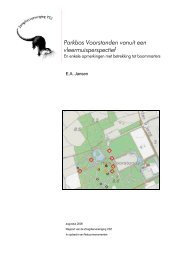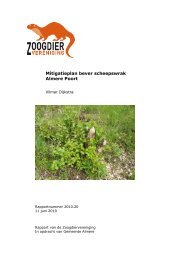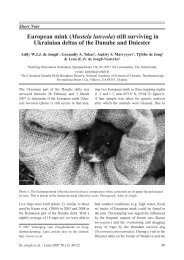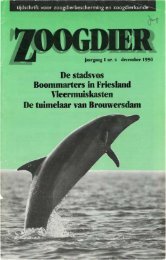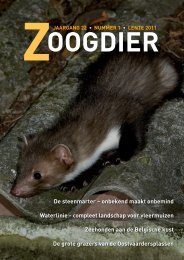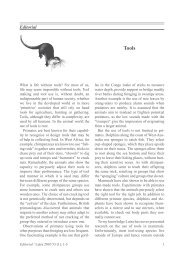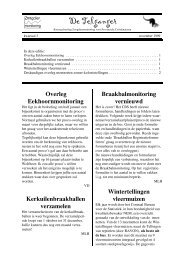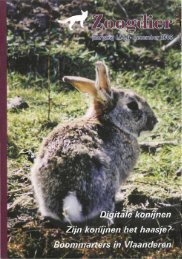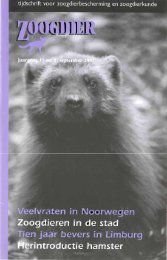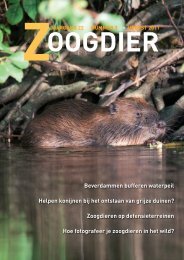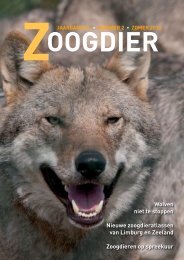binnenwerk 48-2-2005 - De Zoogdiervereniging
binnenwerk 48-2-2005 - De Zoogdiervereniging
binnenwerk 48-2-2005 - De Zoogdiervereniging
You also want an ePaper? Increase the reach of your titles
YUMPU automatically turns print PDFs into web optimized ePapers that Google loves.
The DNA analysis of the hair sample of the catcaught at Heeze convincingly demonstrates thatthis can be considered to be a true wildcat. However,the information on the history of this animalshows that this case was an unintentional introductionfrom the Vosges, and not a result ofspontaneous settlement.We do not consider the other observations,over the past decade, of cats that show some resemblanceto the wildcat, to be positive records.Possibly these are hybrids. These observationsdo however provide circumstantial evidence ofthe presence of wildcat in the area. Moreover,the appearance of hybrids is more likely in theevent of the incidental occurrence of individualpure wildcats.We strongly recommend that, from now onwards,anyone making field observations of yellowishto brownish grey-coloured cats in theNetherlands to be alert to the possibility of awildcat. We urge that such observations shouldbe meticulously recorded, and reported to thedatabase of the (Dutch) Society for the Study andConservation of Mammals (‘<strong>Zoogdiervereniging</strong>VZZ’) in Arnhem. This will help document thepattern of future arrivals of wildcat in theNetherlands, and help underpin future analysisand research. The external characteristics thatdistinguish wildcats from domestic cats can befound in table 1.We would like to stress that many of the characteristicslisted in table 1 are gradual differences.The possible occurrence of hybrids complicatesthis matter even more. One has to try tofind out as much as possible about the relevantcharacteristics to be able to definitively identifythe animal. It is extremely difficult to in the fielddistinguish a wildcat from a domestic cat.Settlement in the NetherlandsTwo positive records, and a few observations ofpossible hybrids, are not sufficient proof of thewildcat settling, or taking up permanent residencein the Netherlands. For that, evidence ofreproduction would be required, preferably severalcases. In this respect the difficulty of distinguishingyoung wildcats from young tabbycoloureddomestic cats poses a problem. Youngwildcats have a prominent pattern of stripes,whereas in adult wildcats this pattern becomesless pronounced, as the guard hairs grow(Piechocki 1990).Possible originThe southeast of the Netherlands borders on theGerman federal state of Nordrhein-Westfalen (tothe east) and Flemish district of the Voerstreek(to the south). The south of the Voerstreek is directlyadjacent to the heavily wooded Ardennesin Wallonia. Vandendriessche & Verkem (2004)mention that between 1987 and 2002 the rangeof the wildcat in Wallonia came close to theVoerstreek, although they point out a lack ofconfirmed observations in the Voerstreek. Libois(1991) mentions that the wildcat was frequentlyobserved in the Hautes Fagnes, about 25 kmaway from the Dutch border of southern Limburg,in the 1970s and 1980s. The previouslydiscussed record of foot prints of a wildcat nearHergenrath, six kilometres south of the Dutchtown of Vaals, shows that the species is presentjust south of the border. The find of a wildcatnear Vaalsbroek corroborates this. However,there is no information from this period (the1990s) on the occurrence of the wildcat alongother parts of the Dutch-Belgian border area(Vandendriessche & Verkem 2004).Although it seems most likely that wildcatsfrom the Ardennes move north and enter theNetherlands through the Voerstreek, it is alsopossible that they come directly from the Eifelhills. Groenlanden, the location of one record, isfar north of the Ardennes and the urban agglomerationof Sittard-Geleen lies between the two. Ittherefore seems more probable that this wildcatcame from the German area in the east, forexample from the Hürtgenwald (Nord-Eifel).This is only about 15 km from the Dutch-German border at Vaals, and wildcats are knownto exist here (www.biostationeuskirchen. de;viewed 18 November <strong>2005</strong>). This animal mightpossibly have been born in the Eifel hills, butCanters et al. / Lutra <strong>2005</strong> <strong>48</strong> (2): 67-90 81



